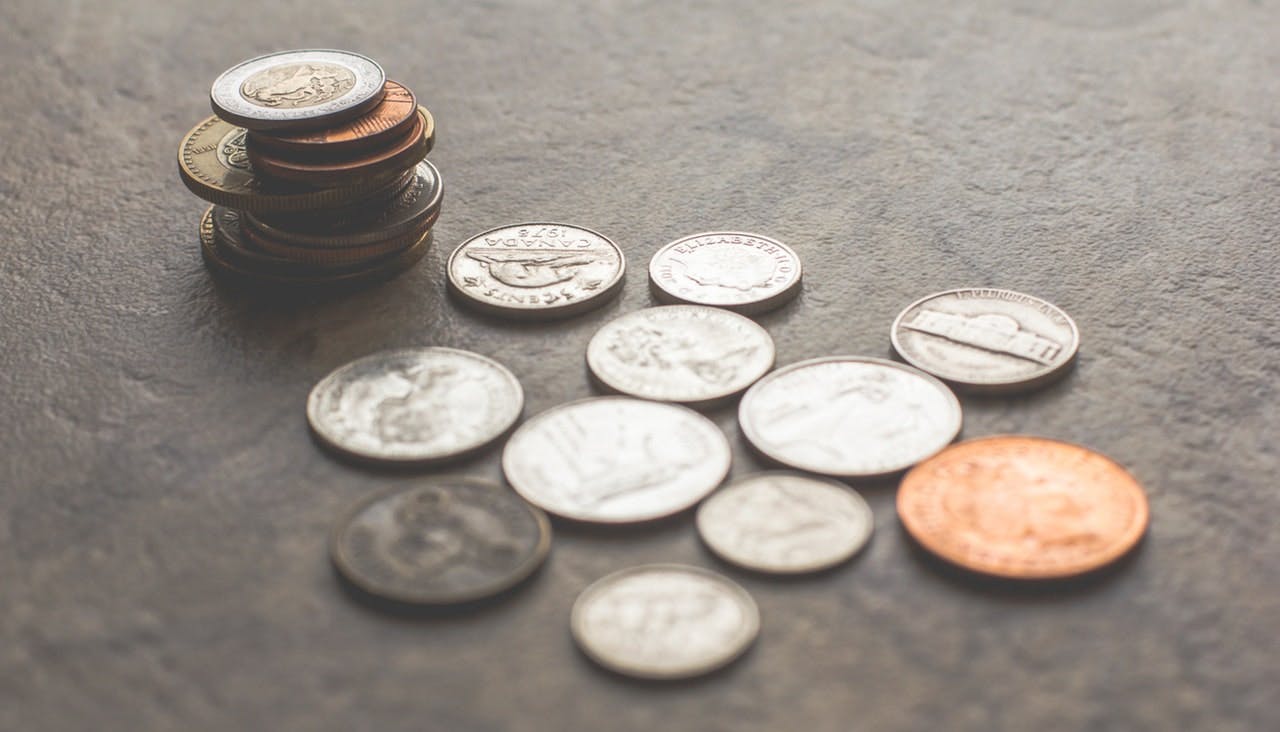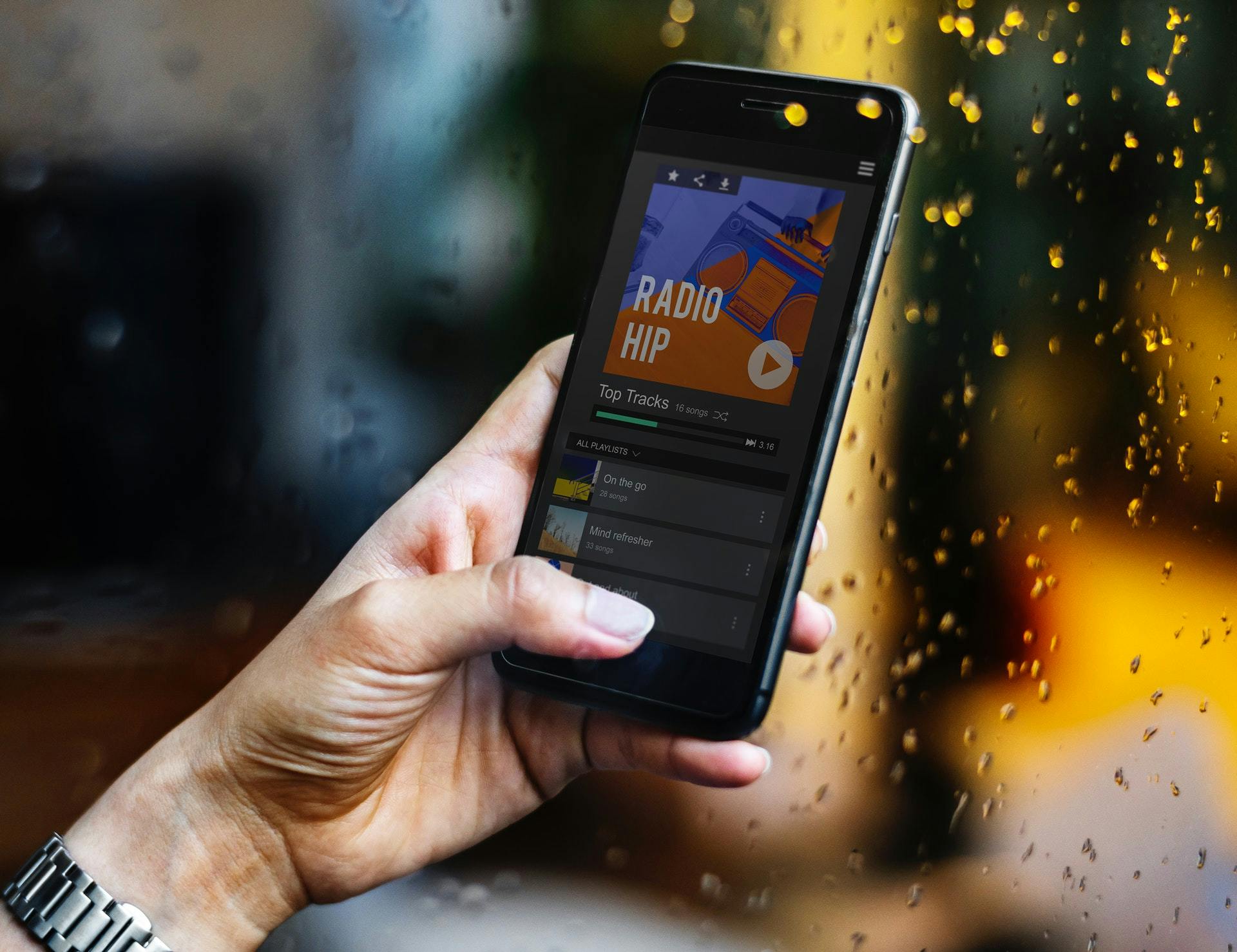Jump to
- 3 Types of Streaming Payouts
- 1. Mechanical Royalties
- 2. Public Performance Royalties
- 3. Payout to Recording Owners
- What Do Major Streaming Services Pay the Artists?
- Streaming Payouts on Spotify, Apple Music, Google Play and Deezer
- Amazon, Napster, and Tidal: the Top-3
- YouTube's Multi-Channel Payout System
- Local Services of JioSaavn, Yandex and Tencent Take the Lower End
- How You Should Actually Think About Streaming Payouts
- How are Streaming Payouts Actually Calculated?
- Not All Streams are Created Equal
- 1. Freemium VS. Subscription-only: The Payout Dilution
- Apple Music vs Spotify: Who’s Paying Artists More?
- 2. Local Spotify, Apple Music, and YouTube Music Payouts
- How Much Does Spotify Pay Artists (Around the Globe)?
- The Variables of Spotify’s Payouts System
- 3. What Makes Napster the Highest-Paying Streaming Platform
- Content Pool and User Engagement
- 4. Deezer: the Case of Sample Bias
- FAQ about Streaming Payouts:
- How does Spotify pay artists?
- How much does Spotify pay per stream?
- How much does Spotify pay per 1000 streams?
- Which streaming service pays the most?
Music streaming is now at the very center of the recording industry. The chances are that the recording artist will make most of the money on streaming, whether it’s an up-and-coming local act or an international superstar — although the second will make about a million times more. As A Boogie Wit Da Hoodie puts it: “we ain’t even got no CDs out”.
At the same time, the music streaming market is becoming exponentially more and more complex. As of 2018, there were over 200 DSPs with streaming capabilities, from regional players and niche services to international giants of Apple, Spotify and alike. We’ve laid out a complete classification of all streaming services over in our article on the Mechanics of Streaming, so check it out if you want to know more.
So, how do you navigate this complex landscape of the streaming market and maximize your streaming revenue? The music industry is full of opportunities, but what are the platforms you should focus on? How much do different DSPs pay the artists? Those questions are on the minds of artists of all scope — after all, it’s their primary revenue source on the recording side. It seems like the first metric to evaluate the platform’s return — and the most obvious one — is the per-stream payout rate. However, if you look into it, it turns out that it’s not really reliable. So, here’s our take on it: in this article, you will find out what are the streaming rates, and why they might not be as important as you think.
3 Types of Streaming Payouts
Before we get into it, a quick side note. For every stream (or almost every stream), DSPs make three different payments to right-holders:
1. Mechanical Royalties
Mechanical royalties are paid to songwriters and their publishers (the owners of composition) for the right to reproduce the composition. Back in the day, that mechanical royalties were due whenever someone wanted to mechanically produce the physical medium carrying the composition — hence the name — but in the word of streaming, they are generated whenever the user chooses to play a song. You might remember the recent story on Spotify’s clash with publishers in the light of CRB's decision. Well, that was all about mechanical royalties.
2. Public Performance Royalties
Performance royalties paid to songwriters and their publishers for the right to publicly perform their music. Since none of the music is technically owned by the user, every stream is considered a public performance — even if it is enjoyed in the privacy of one’s headphones.
3. Payout to Recording Owners
The third, and the most substantial part of the overall payout is owed to the owners of the copyright on the recording side through labels and distributors. If someone asks "how much does Spotify pay artists?", 99% of the time it will be the payout to recording owners that they're looking for.
While the mechanical and public performance royalties are a subject of a local legislation and can differ from country to country, almost all of the streaming services use pretty much the same set of rules for calculating this last part of the payout. Check out our Mechanics of Streaming if you want to know more about the overall costs of streaming — the point is that in this article we will focus exclusively on payouts to the sound recording owners, leaving the publishing royalties out of scope.
What Do Major Streaming Services Pay the Artists?
So, what are the payout rates across the streaming services? There are two sources behind the most quotes you will see on the web: Digital Music News’ article on payout rates and The Trichordist’s 2018 Streaming Price Bible, which calculates the payout rate based on the sales data of a mid-scale indie label, that add up to over a billion streams. We’ve decided to follow in The Trichordist’s steps and got data from our friendly label, covering two artists: the prominent international electronic act and mid-scale hip-hop band. In total, those artists have generated over 500 million streams throughout 2018.
Streaming Payouts on Spotify, Apple Music, Google Play and Deezer
We’ve calculated the weighted average payout rate, taking into account the proprietary sample as well as the quotes provided by Digital Music News and The Trichordist. The complete table can be found below, but here’s a TL;DR summary for what we’ve got:
- Spotify paid the artists $0,0032 per stream
You can still check out this Spotify Royalty Calculator if you want to get a better idea of how much you can earn from your Spotify streams! - Apple Music got the average rate of $0,0056
- Google Play Music landed a $0,0055 payout rate
- Deezer fell slightly lower at $0.00436
This quote was observed before Deezer introduced its user-centric payment system.

Weighted Average Per-Stream Payout Rate, by Platform, USD
Source: Digital Music News, The Trichordist, Soundcharts
Amazon, Napster, and Tidal: the Top-3
In full detail: Amazon Music Unlimited, Napster and Tidal got the top-3 rates at $0,0119, $0.0106 and $0.0099 respectively. However, don’t get too excited about Amazon’s numbers. The lion’s share of the tech giants subscribers are in fact over at Amazon Prime bundled streaming service — and for Amazon Prime, the average rate came to just 28% of the Unlimited’s payout, or $0,0034.
YouTube's Multi-Channel Payout System
Youtube is a multi-sided platform in terms of payout. There are at least three separate payouts under the brands’ umbrella: per YouTube Premium/YouTube Music stream ($0.008), per video-stream on the official artist’s channels ($0.00164) and videos monetized through Content ID ($0.00087).
Local Services of JioSaavn, Yandex and Tencent Take the Lower End
As expected, the lower end of the payout breakdown is occupied by the local digital services on the developing streaming markets: Indian JioSaavn ($0.0013), Russian UMA and Yandex ($0,00102 and $0.0005, respectively) and Tencent’s QQ — with the lowest observed rate at $0.0004 per stream.
Here’s the complete table of payout rates we’ve observed:
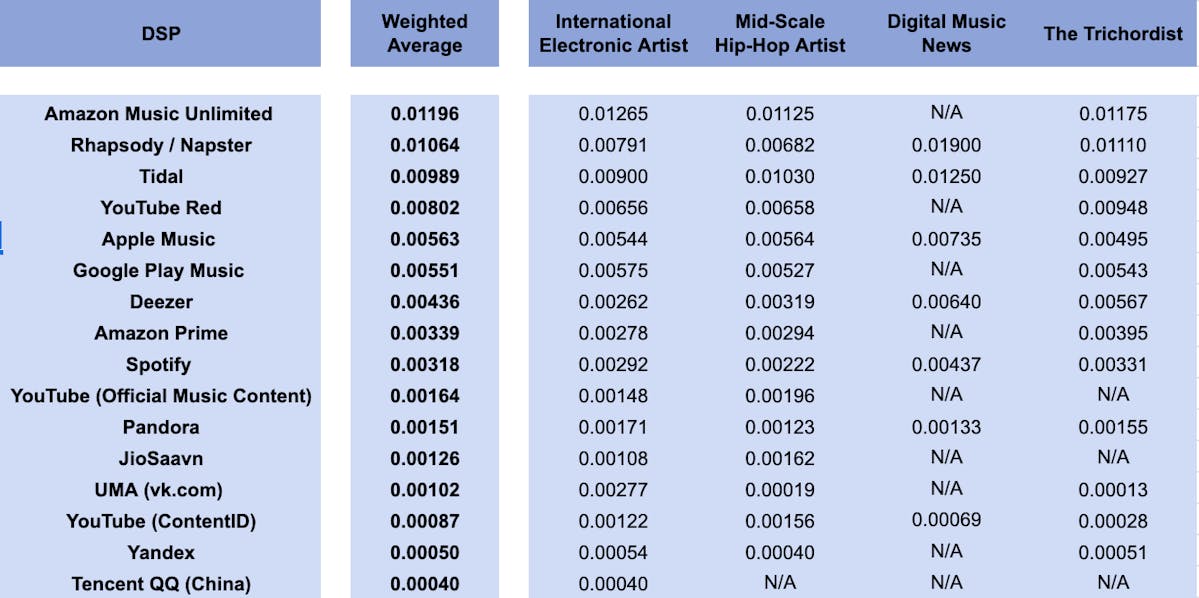
Average Per-Stream Payout Rate, by Source and Platform, USD
Source: Digital Music News, The Trichordist, Soundcharts
With that out of the way, let’s get real. The fact is that you shouldn't care about the per-stream payout rate.
How You Should Actually Think About Streaming Payouts
So, let’s take a step back and look at how the digital services actually calculate the artist’s total payout. Most of the streaming services, from Spotify and Apple to Google Play and Napster use what is referred to as “pro-rata” or “platform-centric” payout distribution model. Here’s how it works:
On the DSP side, services negotiate global payout rates with the content owners (mainly the major labels and Merlin, which represents a vast share of independent catalog). As we’ve argued in the Mechanics of Streaming, this rate is likely to fall in the range from 60% to 70% for every streaming service out there, but let’s use the 70% for the sake of simplicity. The negotiated rate is applied to all service’s revenues, and the result is the total sum that the DSP will pay out to right holders. It's a revenue pool that will be split between all artists on the platform. To divvy up that pie between the artists, DSP will calculate a "share of content" — the number of the artist streams divided by all streams on the platform.
How are Streaming Payouts Actually Calculated?
Let’s use an example. Imagine a streaming service X has made $1000 in revenues in one month, with a 70% payout rate. Out of that 70%, 57% is the cut of the recording owners, and publishers claim the remaining 13% in performance and mechanical royalties.
Now, if there were a total of 1 million streams on the platforms over the period, and your music generated 100,000 streams out of that million, your total payout would make $57 = (1000 * 57% * 100,000/1,000,000). Your songwriter would get another $13.
This model is not without its flaws, and some professionals in the music business are calling for a shift to user-centric payouts — which is a topic we might explore in the future. For now, however, the payout that you get from any streaming service (except for YouTube video-streaming, and, as of late, Deezer's user-centric payout) is a function of:
- Total DSP’s revenue pool
- Negotiated global payout as a percentage of that revenue
- Total number of streams on the platform
- The number of your streams on the platform
Not All Streams are Created Equal
However — and here is where things get interesting — there is no such thing as a global, all-in revenue/content pool. Instead, there are dozens of separate buckets: for every subscription tier, every local market and so on. All the different types of streams create distinct content pools, and that means one simple thing. Not all streams are equally valuable. You wouldn’t try to cross a river because it is 4 feet deep on average. Accordingly, you shouldn’t judge the artist’s earnings on the platform based on the average per-stream payout.
For any artist out there, the per-stream rate will be in constant flux — simply because there are hundreds of factors affecting the overall revenue. The payout rate depends on who, where and how much streams your music — which is precisely the reason for inconsistency between the quotes you can find around the web. With that in mind, let’s look at the data once again, and put some real-world context behind it.
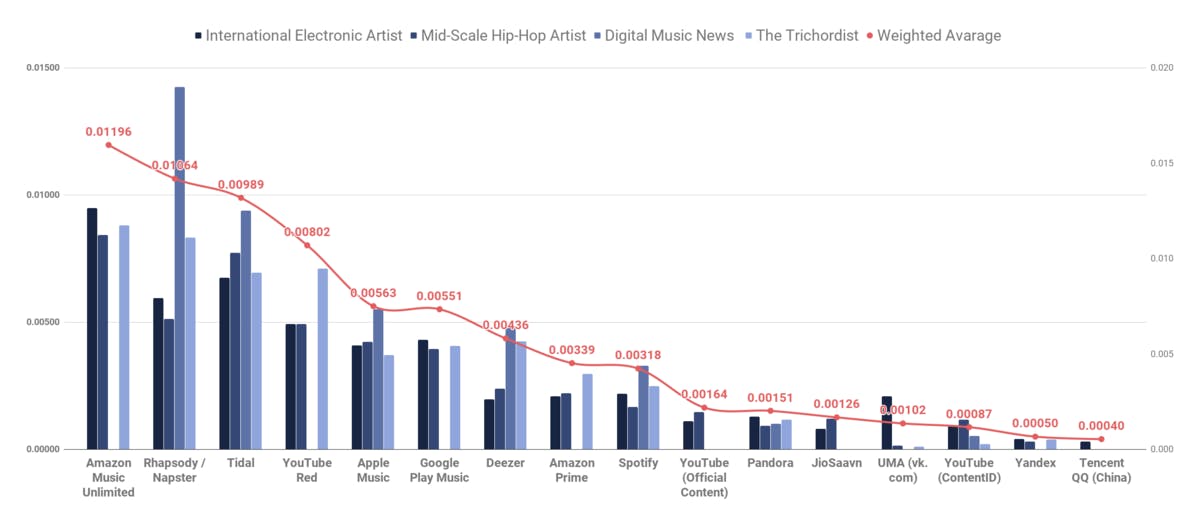
Average Per-Stream Payout Rate, by Source and Platform, USD
Source: Digital Music News, The Trichordist, Soundcharts
1. Freemium VS. Subscription-only: The Payout Dilution
The first big differentiator is whether streams are generated by free or premium users. Right out of the gate, the fact that the streaming services use different subscription models, renders the average per stream payout a faulty metric. Let's look at the Spotify and Apple Music respective payouts:
Apple Music vs Spotify: Who’s Paying Artists More?
So, the average observed per-stream payout on Apple Music is $0.00551 vs. $0.00318 for Spotify. Does that mean that Apple Music is paying artists more than Spotify? Well, maybe. However, the average payout rate alone is not enough to make this conclusion.
According to the latest reports, Apple Music has 56 million subscribers worldwide. Spotify claims 96 million paying users as of December 2018. However, that’s just a part of the company’s total of 207 million monthly active user-base, as the remaining 111 million are the users of Spotify’s ad-supported version.
At the same time, if Spotify has an ARPU of $4,81 for its premium users, it’s ad-supported version brings just 10,6% of that sum, with an ARPU of $0,51. Ad-supported users create a separate revenue/content pool and, while the streams counts should be comparable to the premium one, the ad-supported revenue is nowhere near the premium figures. At the same time, as you remember, the service’s income is the first step of the payout calculation.
So, the free user’s streams dilute the premium ones, and the average payout goes down. Which shouldn’t really bother you as much: the premium audiences of Spotify still bring in the same value through their isolated cashflow. It’s just that you have a much more shallow, ad-supported pool sitting on top of it. Of course, you could argue that the presence of an ad-supported version itself diminishes the overall artist revenue since those free users would otherwise have to pay for subscriptions — but that is a topic for a separate debate.
The payout dilution is not just about Apple Music and Spotify. In fact, all 6 top platforms in terms of per-stream payouts don’t have a free, ad-supported version. Besides, it’s not only about who listens to your music — but also where people listen to it. The second big differentiator of the value of the stream is the market where it has originated.
2. Local Spotify, Apple Music, and YouTube Music Payouts
As of late, most of the prominent global streaming brands, from Spotify and Amazon to YouTube Music and Deezer have entered a number developing streaming markets. The global expansion of the market is one of the main trends in the streaming business — and that alone is bound to bring down the all-around global per-stream payout.
How Much Does Spotify Pay Artists (Around the Globe)?
Take an example of Spotify. The Swedish streaming giant has recently entered the Indian market. However, if in the U.S. Spotify Premium is priced at $9,99 a month, in India Spotify had to bring the prices down to compete with the local offers of JioSaavn and alike. In fact, in India, Spotify put the lowest-ever price tag on its premium service, at just $1,7/month. That approach is not new: streaming services prices vary around the world.

Spotify Premium Price in Selected Markets, USD
Source: Music Business Worldwide
Such spread is not only a Spotify thing: Apple Music, YouTube Music, you name it — every global streaming service has to keep the local prices flexible to stay competitive across the globe. That has a massive impact on the value of the streams that are coming from those regions.
Let’s look at per-stream payouts once again, but focus on the lower end of the distribution. Russian UMA and Yandex have rates of $0.001 and $0.0005. JioSaavn, the most popular streaming service in India, pays just $0.00126 per stream. So, if the local instalments of Spotify, Apple Music and YouTube Music have to match the price of JioSaavn’s offer — well, you can expect that the regional per-stream payout will be comparable.
The Variables of Spotify’s Payouts System
So, Spotify’s per-stream payout is a metric that summarises payouts over at least 12 different local premium pricing tiers, from $13,12 in the UK to $1,7 in India. Furthermore, in all of those markets, there’s also a great deal of ad-supported streams. The average payout summarizes the payouts across at least 24 different revenue/content pools, and there’s no way to tell how the streams behind the numbers are distributed across all those local markets and pricing tiers. So, instead of looking for universal, international payout rate, we might be better off asking ourselves: where do the streams come from?
The two factors mentioned above, the fragmentation of the user-base based on subscription tier and market are affecting the first section of the payout formula — the DSP’s revenue pool. To be precise, they split the overall revenue pool into dozens of smaller ones. That means that streams don’t bring the same value — undermining the very idea of the average per-stream payout metric. However, that is just the first part of the problem.
3. What Makes Napster the Highest-Paying Streaming Platform
Let’s get a bit mathematical for a moment. To calculate the Total Payout of the DSP across the entire revenue/content pool, we need to take total revenue in that pool (Number of Users * Average Revenue Per User) and multiply it by negotiated global payout rate. Hence:

The Per-Stream Payout, in its turn, is the Total Payout, divided by the Number of Streams in the corresponding content pool, or:

However, if we simplify the formula, and express the (Number of Streams/Number of Users) ratio as the Average Streams Per User, it turns out that the Per-Stream Payout is a function of just three figures:

- Average revenue per user (within a specific revenue/content pool)
- Global payout rate
- Average streams per user (within a specific revenue/content pool)
As we’ve argued, the global payout rate should be pretty much the same across different DSPs. The minor fluctuations are possible but not to the extent that can explain the overall spread. Instead, the problem lies in the third part of the calculation — the average streams per users.
Content Pool and User Engagement
The formula above means one simple thing. For premium subscriptions with a stable ARPU, the per-stream rate goes up as the user's engagement with the platform, expressed as the average streams per user, goes down. Imagine that every customer would stream just one song per month. In that case, the per-stream payout would skyrocket to $5 — but no one would really win. It doesn’t matter if you get 5000 streams worth $0.001 or a single stream worth $5 — the artists would still make the same money. The only change is that their music would be played less.
In that sense, when Spotify releases a new retention feature and raises average listening on the platform — introducing autoplay or enhancing its playlist experience — it inevitably brings down the per-stream payout rate. However, since there are more total streams to go around, the total payout stays the same.
If, on the contrary, a streaming platform does a poor job keeping its customers engaged, the per-stream payout grows. A high payout rate is a sign of low usage-rate on the platform, more so than it is a sign of the service’s fairness to the artist.
And now, the final nail in the per-stream payout’s coffin: there’s no statistically relevant quote for the per-stream payout anyway.
4. Deezer: the Case of Sample Bias
Disclaimer: This article was written before Deezer introduced its user-centric payment system. The data you'll find below is a reflection of the old, content-centric Deezer payout — although you could argue that the new payout system won't actually change much.
Given the complex revenue pool structure, virtually every sample — even The Trichordist’s Streaming Bible’s “Billion of streams over 250+ albums” — will be tilted and thus fail to reflect the actual average rates. To showcase, let’s review the quotes we’ve got from all the sources for Deezer:
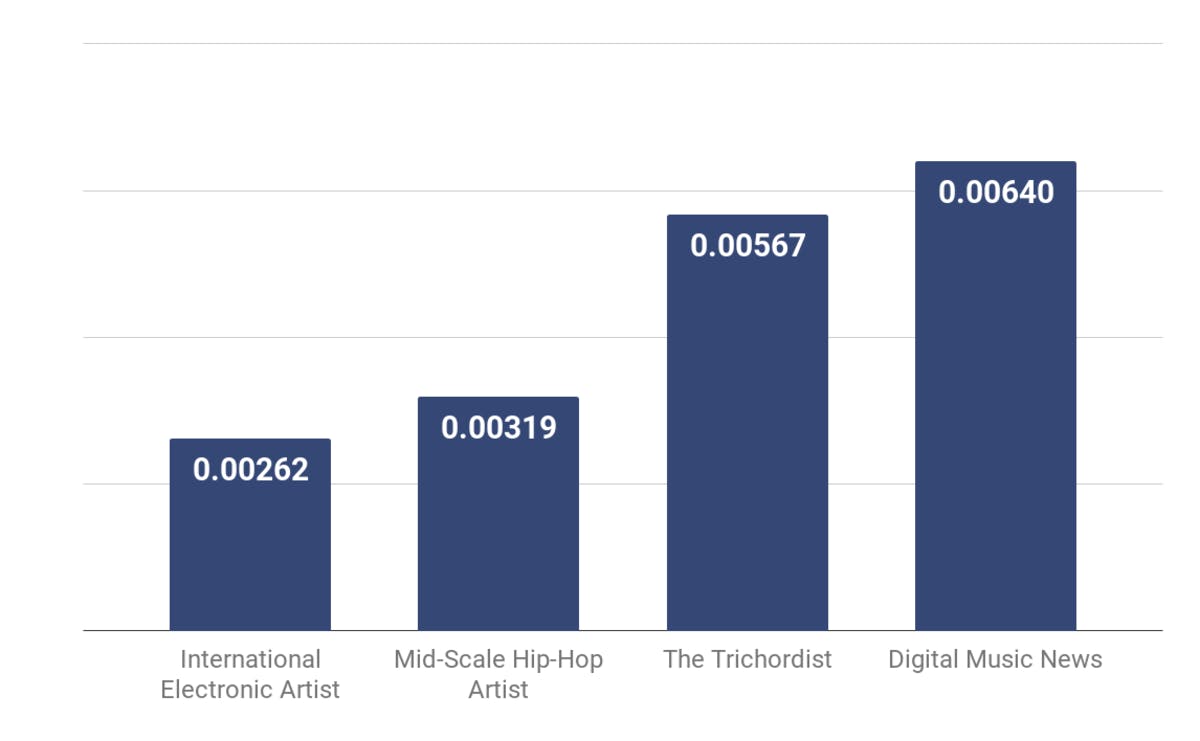
Deezer average per-stream payout rate, by source, USD
Source: Digital Music News, The Trichordist, Soundcharts
As you can see, the quoted rates differ a lot, from $0.00262 to almost three times that, or $0,0064. But which one is closer to the truth, then? Let’s check out the sample. While Digital Music News doesn’t disclose the details, The Trichordist’s data-sheet states that Deezer accounted for just 0,91% of the billion-stream sample or 9,100,000 streams.
As for the Soundcharts’ data, both of the artists studied are based in France, Deezer’s domestic market — and so the streams on the platform took a much larger share of the sample. In the end, Soundcharts’ platform-specific sample for Deezer was about 4-times the size of The Trichordist’s one.
Our guess is that at that scale, the “freemium effect” kicked in and the per-stream payouts went down, as described in the section above. There might be other, unforeseen reasons but the real outtake is that with the number of factors involved, it’s nearly impossible to put together a representative sample to assess the average payouts across all platforms.
The per-stream payout rate is a metric that tries to summarize dozens of cash flows based on a biased sample. Then it’s used to compare the services’ pay the artists — and it might be adequate when estimating the payouts of local streaming services. However, when it comes to comparison of global services of Spotify Apple Music and alike, we might be better off without such insights. Misleading data is worse than no data at all.
FAQ about Streaming Payouts:
How does Spotify pay artists?
That very much depends on the type of rights we're talking about, as well as the way the royalty pipeline is set up. On the master side, Spotify generally pays the royalties through distribution companies like Believe or TuneCore, or directly to the record label, if it has a direct licensing agreement with the platform (like Warner, Sony and Universal do). On the composition side or the copyright, Spotify pays royalties to songwriters through Performance Rights Organizations (PROs), or, once again, directly to huge publishing companies, that have direct relationships with the streaming service.
How much does Spotify pay per stream?
On average, Spotify pays the copyright holder(s) of the master recording $0.00318 per stream. However, as we've argued above, the per-stream payout will hugely depend on the type of streams the artist gets. Besides, the actual cash in the artist's pocket will also depend on the contracts in place (between the artist, the label and the distributor).
How much does Spotify pay per 1000 streams?
Since the average stream pays $0.00318, 1000 streams on Spotify will earn the rights holder(s) of a musical work about $3.18.
Which streaming service pays the most?
Amazon Music Unlimited pays the most of any streaming service at $0.012 per stream, and the music subscription service Rhapsody is next-highest at $0.011 per stream. However, you can expect that a total stream count on those platforms will be minuscule compared to Spotify, Apple Music, YouTube or Pandora
